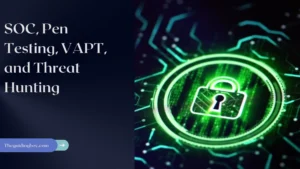In our rapidly evolving digital landscape, the need for robust cybersecurity measures has never been more critical. As technology advances, so do the threats that jeopardize our sensitive information and digital infrastructure. Cybersecurity professionals play a pivotal role in safeguarding our digital world, and their responsibilities span a wide range of roles. In this article, we will delve into the world of cybersecurity, exploring various job roles and shedding light on the differences between Security Operations Center (SOC), Penetration Testing, Vulnerability Assessment and Penetration Testing (VAPT), and Threat Hunting, all illustrated with real-life examples.

Understanding Cybersecurity Jobs
- Security Operations Center (SOC) Analysts
SOC analysts are the frontline defenders of an organization’s digital assets. They monitor network security, analyze vulnerabilities, and respond to incidents in real-time. Their primary goal is to ensure the continuous availability, integrity, and confidentiality of data. SOC analysts use advanced tools to detect and mitigate cyber threats, such as malware and unauthorized access attempts.
Real-Life Example: Consider a large financial institution with millions of transactions daily. A SOC analyst would be responsible for monitoring logs and alerts, identifying any unusual patterns, and responding promptly to prevent a potential cyberattack.
- Penetration Testing (Pen Testers)
Penetration testers, also known as ethical hackers, are tasked with assessing the security of a system, network, or application by simulating cyberattacks. Their goal is to identify vulnerabilities before malicious hackers can exploit them. Pen testers use various tools and techniques to simulate real-world cyber threats, providing organizations with valuable insights to strengthen their defenses.
Real-Life Example: Imagine a cybersecurity firm hired by an e-commerce company to conduct a penetration test on its online platform. The pen testers simulate a phishing attack to identify potential weaknesses in the company’s email security, ensuring that customer data remains secure.
- Vulnerability Assessment and Penetration Testing (VAPT) Professionals
VAPT professionals combine the strengths of vulnerability assessment and penetration testing. They conduct thorough assessments to identify vulnerabilities, weaknesses, and potential entry points for cyber attackers. VAPT professionals not only pinpoint weaknesses but also simulate actual exploitation to gauge the severity of identified vulnerabilities.
Real-Life Example: An international software company may hire VAPT professionals to assess the security of its newly developed software before launch. By identifying and patching vulnerabilities early in the development phase, the company ensures a secure product for its users.
- Threat Hunters
Threat hunters proactively search for signs of cyber threats within an organization’s network. Unlike traditional cybersecurity measures that rely on automated tools, threat hunting involves a more hands-on approach. Threat hunters use their expertise to identify unusual patterns, behaviors, or indicators of compromise that may go undetected by automated systems.
Real-Life Example: Picture a global tech company that, despite having robust cybersecurity measures in place, notices a slight uptick in network anomalies. A threat hunter would investigate these anomalies, looking for signs of a potential breach, and, if necessary, collaborate with the SOC to mitigate the threat.
Distinguishing Between SOC, Pen Testing, VAPT, and Threat Hunting
- Focus and Approach
- SOC: Reactive approach, focusing on real-time monitoring and incident response.
- Pen Testing: Proactive approach, simulating cyberattacks to identify vulnerabilities.
- VAPT: Comprehensive approach, combining vulnerability assessment and penetration testing for a holistic security evaluation.
- Threat Hunting: Proactive approach, actively seeking signs of threats within the network.
- Timeframe
- SOC: Continuous monitoring and immediate incident response.
- Pen Testing: Conducted periodically, often annually or during major system updates.
- VAPT: Can be scheduled periodically or performed during different stages of software development.
- Threat Hunting: Ongoing, with no fixed schedule.
- Skill Sets
- SOC: Strong analytical skills, familiarity with security tools, and the ability to respond quickly to incidents.
- Pen Testing: In-depth knowledge of hacking techniques, programming skills, and the ability to think like a hacker.
- VAPT: Combination of skills required for both vulnerability assessment and penetration testing.
- Threat Hunting: Deep understanding of network behavior, forensics, and the ability to identify subtle indicators of compromise.
Real-Life Examples to Illustrate Differences
- SOC in Action Imagine a retail company with an online presence. A SOC analyst notices an unusual spike in traffic to the payment processing servers. Realizing this could be a Distributed Denial of Service (DDoS) attack, the analyst quickly implements countermeasures, mitigating the threat and ensuring uninterrupted service for customers.
- Pen Testing in a Corporate Setting A multinational corporation is about to launch a new customer portal. Before the official release, the company hires a penetration testing team to assess the portal’s security. The team identifies a vulnerability in the login system that, if exploited, could grant unauthorized access. The company promptly addresses the issue, preventing potential data breaches.
- VAPT for Software Development An emerging software company is developing a cutting-edge application. To ensure its security, the company engages VAPT professionals. The assessment reveals vulnerabilities in the software’s authentication process and potential weaknesses in data encryption. By addressing these issues before the product launch, the company ensures a secure user experience.
- Threat Hunting in a Tech Giant A leading technology company, known for its innovative solutions, notices a slight deviation in user behavior on its cloud platform. A threat hunter investigates and discovers a sophisticated malware variant attempting to exfiltrate sensitive data. By swiftly containing and eliminating the threat, the company prevents a potential data breach and protects its clients’ information.
Conclusion
In the dynamic landscape of cybersecurity, understanding the various roles and responsibilities is crucial. Security Operations Center (SOC), Penetration Testing, Vulnerability Assessment and Penetration Testing (VAPT), and Threat Hunting each play a unique yet interconnected role in fortifying our digital defenses. By comprehending the distinctions between these roles and recognising their real-world applications, organisations can build resilient cybersecurity strategies to protect against the ever-evolving threat landscape. As technology continues to advance, the importance of these cybersecurity roles will only grow, making them integral to the digital security posture of any organization.